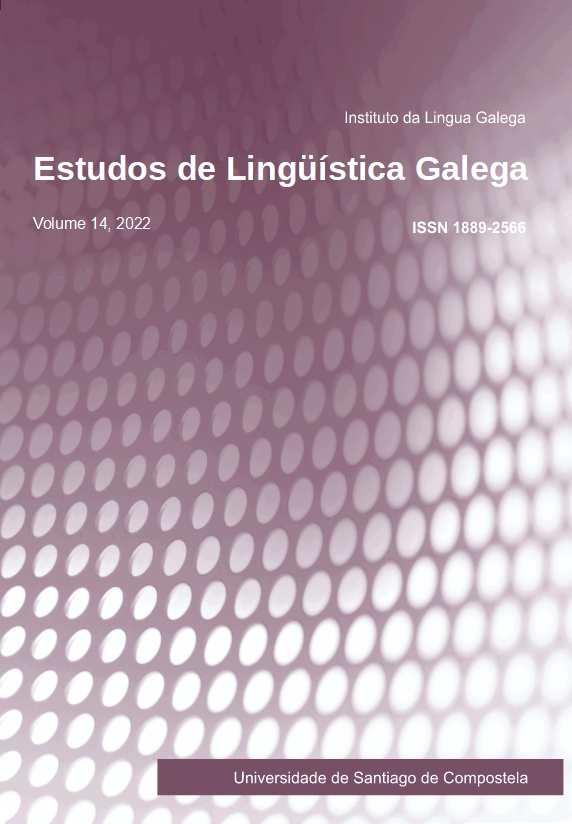Oral diphthongs and their development processes in the history of Portuguese
Main Article Content
Abstract
Keywords:
Article Details
References
Barbosa, Jorge Manuel de Morais Gomes (1958): Cronica de Castela (ms. 8817 da Biblioteca Nacional de Madrid). Elementos para o estudo linguístico. Texto (Fernando I – Afonso VI). Volume I (Introdução e elementos para o estudo linguístico). Vol. II (Texto). Vol. III (Glossário). Dissertação de licenciatura em Filologia Românica, inédita. Faculdade de Letras, Universidade de Lisboa.
Boullón Agrelo, Ana Isabel (1999): Antroponímia medieval galega (ss. VIII-XII). Tübingen: Max Niemeyer Verlag.
Cardeira, Esperança (2005): Entre o Português Antigo e o Português Clássico. Lisboa: Imprensa Nacional – Casa da Moeda.
Cardeira, Esperança / Maria Alice Fernandes (1997): “Aspectos do português algarvio na transição do século XIV para o XV”, em Ivo Castro (ed.), Actas do XII Encontro Nacional da Associação Portuguesa de Linguística (Braga-Guimarães, 30 de Setembro a 2 de Outubro de 1996), vol. II. Lisboa: Associação Portuguesa de Linguística, 55-68.
Carvalho, Maria José (1999): “A alomorfia no plural dos nomes de lexema em -l: um estudo de morfologia histórica portuguesa”, em Ana Cristina Macário Lopes / Cristina Martins (orgs.), Actas do XIV Encontro Nacional da Associação Portuguesa de Linguística, vol. I. Braga: Associação Portuguesa de Linguística, 265-281.
Carvalho, Maria José (2000): “O morfema -des na história da língua portuguesa. Uma abordagem segundo a metodologia da Sociolinguística histórica”, em Annick Englebert / Michel Pierrard / Laurence Rosier / Dan Van Raemdonck (eds.), Actes du XXIIe Congrès International de Linguistique et de Philologie Romanes (23-29 juillet 1998), vol. II. Tübingen: Max Niemeyer Verlag, 65-74.
Carvalho, Maria José (2006): Documentação medieval do mosteiro de Santa Maria de Alcobaça (sécs. XIII-XVI). Edição e estudo linguístico. Dissertação de doutoramento apresentada à Faculdade de Letras da Universidade de Coimbra [O corpus incluído nesta tese foi publicado em Verba, Anexo 74].
Carvalho, Maria José (2011): “From Etimology to Cognitive Sociolinguistics. A Case-Study from European Portuguese”, em Augusto Soares da Silva / Amadeu Torres / Miguel Gonçalves (orgs./eds.), Línguas pluricêntricas. Variação Linguística e Dimensões Sociocognitivas / Pluricentric Languages. Linguistic Variation and Sociocognitive Dimensions. Braga: Aletheia, 353 - 364.
Carvalho, Maria José (2015a): “Sobre as origens dos valores de /e/ átono em posição medial no Português europeu e brasileiro”, Revista Galega de Filoloxía 16, 43-73. doi: 10.17979/rgf.2015.16.0.1378. [27/12/ 2017]
Carvalho, Maria José (2015b): “Sobre as origens de [u] átono no Português europeu contemporâneo: variação, mudança e dimensões sociocognitivas”, Diacrítica. Série Ciências da Linguagem 29/1, 171-202. http://www.scielo.mec.pt/scielo.php?script=sci_arttext&pid= http://www.scielo.mec.pt/scielo.php?script=sci_arttext&pid=S-0807-89672015000100007&lng [27/12/ 2017]
Carvalho, Maria José (2017): Documentação medieval do mosteiro de Santa Maria de Alcobaça. Edição, com introdução e notas de aparato crítico. (= Verba, Anexo 74). Santiago de Compostela: Servicio de Publicacións e Intercambio Cientifico. http://dx.doi.org/10.15304/9788416533817[27/12/ 2017].
Castro, Ivo (com a colaboração de Rita Marquilhas e José León Acosta) (1991): Curso de história da língua portuguesa. Lisboa: Universidade Aberta.
Ferreiro, Manuel (1999): Gramática Histórica Galega. I. Fonética e Morfosintaxe. Santiago de Compostela: Edicións Laiovento.
Kabatek, Johannes (2001): “¿Cómo investigar las tradiciones discursivas medievales? El ejemplo de los textos jurídicos castellanos”, em Daniel Jacob / Johannes Kabatek (orgs.), Lengua medieval y tradiciones discursivas en la Península Ibérica: descipción gramatical – pragmática histórica – metodologia. Frankfurt am Main / Madrid: Iberoamericana Vervuert, 97-132 (Linguística Iberoamericana, 12).
Lorenzo, Ramón (1977): La traducción gallega de la Crónica General y de la Crónica de Castilla, vol II (Glosario). Ourense: Instituto de Estudos Orensanos “Padre Feijoo”.
Maia, Clarinda (19972): História do galego-português. Estado linguístico da Galiza e do Noroeste de Portugal desde o século XIII ao século XVI. Lisboa: FCG/JNICT.
Nunes, José Joaquim (19899): Compêndio de Gramática Histórica Portuguesa (Fonética e Morfologia). Lisboa: Clássica Editora.
Teyssier, P. (1980): Histoire de la langue portuguaise. Paris: Klincksieck.
Veiga Rodríguez, A. (1986): “Notas sobre algúns procesos reductivos de ditongos decrescentes en galego”, Verba 13, 301-311. https://minerva.usc.es/xmlui/bitstream/handle/10347/4900/pg_303-314_verba13.pdf?sequence=1&isAllowed=y [27/12/ 2017].







